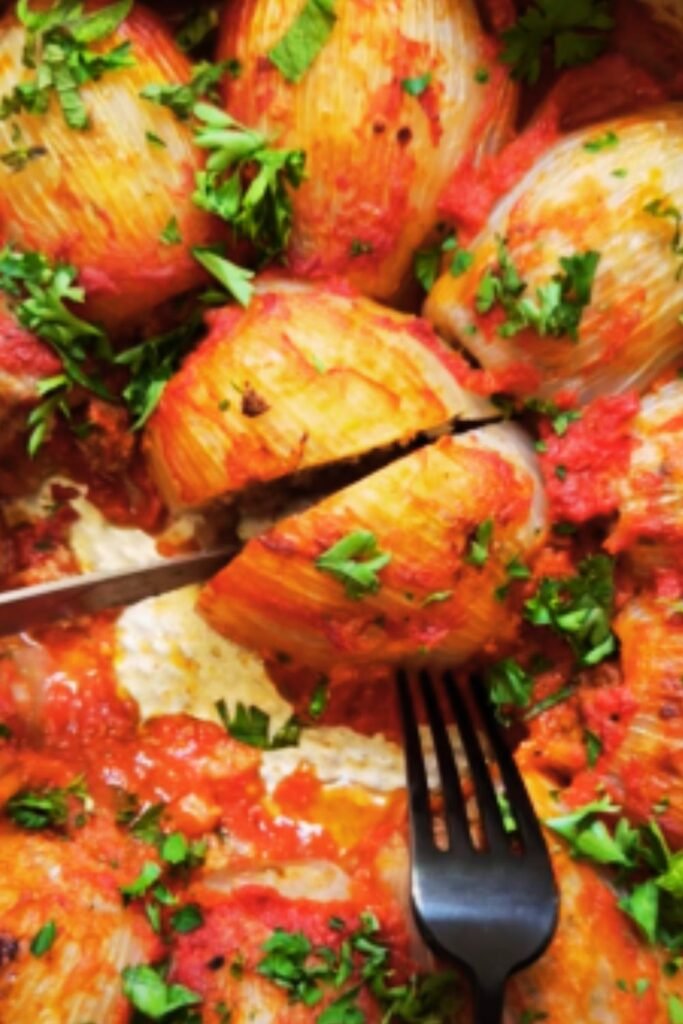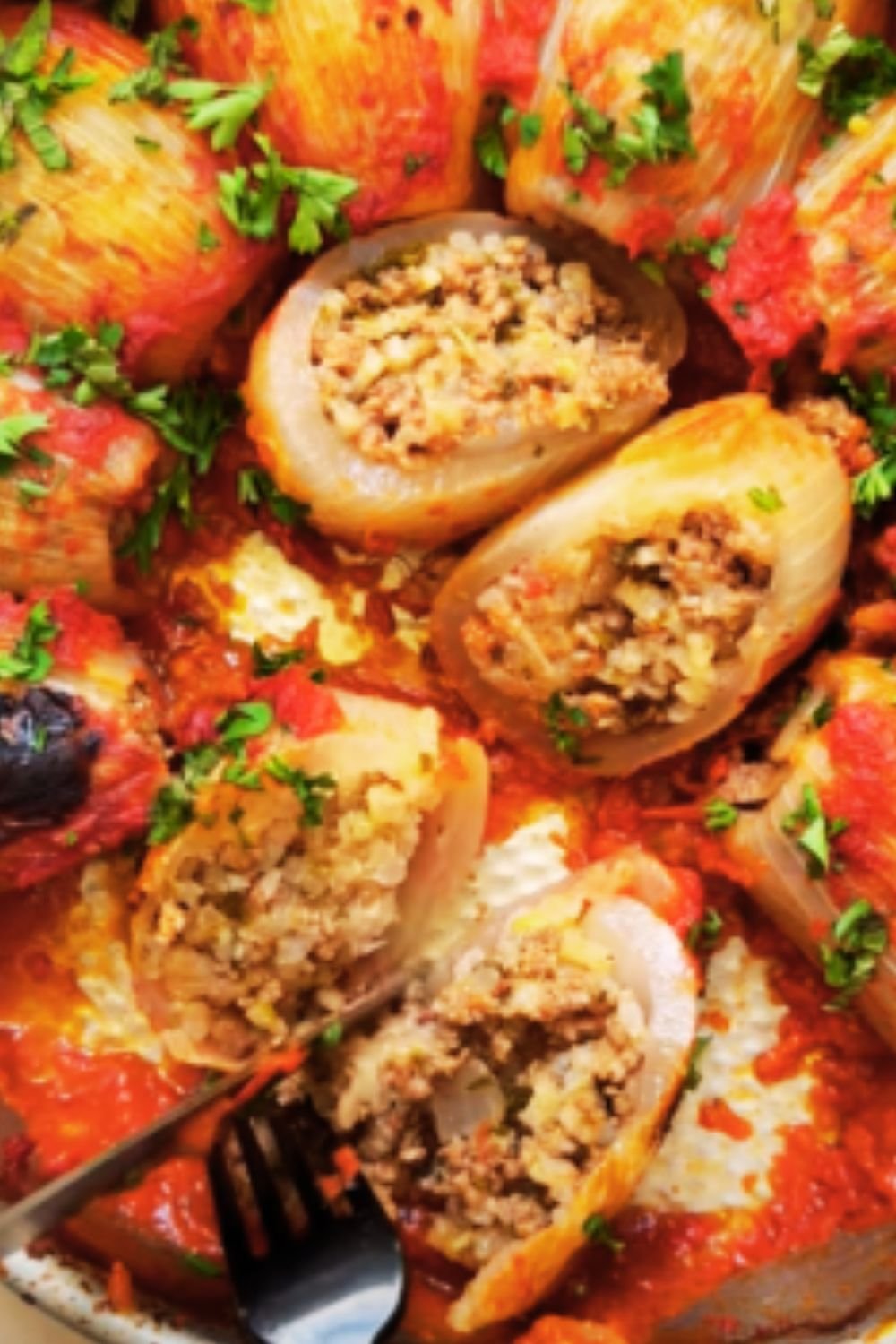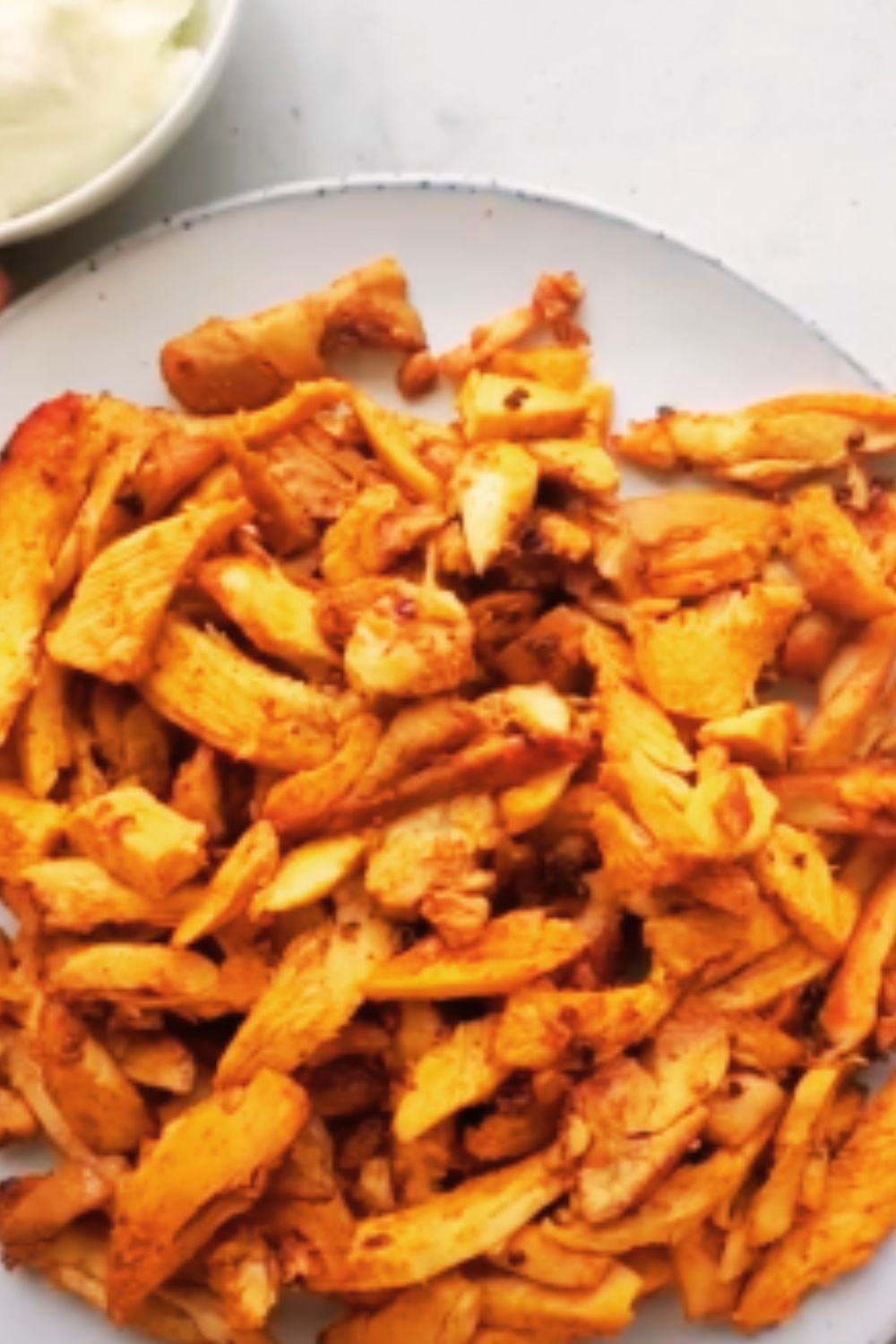Have you ever wondered what to do with those large, beautiful onions sitting in your pantry? Today, I’m excited to share one of my absolute favorite traditional Greek recipes that transforms humble onions into a culinary masterpiece. Salantourmasi, or Greek stuffed onions, is a dish that speaks of family gatherings, village celebrations, and the ingenuity of Greek cooks who could turn simple ingredients into something extraordinary.
As someone who has spent years exploring Greek cuisine, I’ve found that stuffed onions represent the heart of Mediterranean cooking – resourceful, flavorful, and deeply satisfying. This dish might not be as internationally recognized as moussaka or souvlaki, but it holds a special place in authentic Greek households.
A Brief History of Salantourmasi
Salantourmasi originates from rural Greece, particularly popular in the northern regions and islands where large, sweet onions grow abundantly. The name itself has Turkish influences, reflecting the historical Ottoman presence in Greece, though the dish has evolved to become distinctly Greek in character.
I first encountered this dish during a stay with a family in a small village near Thessaloniki. The grandmother, with hands weathered by decades of cooking, showed me how to hollow out onions with practiced precision, waste nothing, and create a filling that would complement the natural sweetness of the onions.
What fascinates me about Salantourmasi is how it represents the philosophy of Greek cooking – transforming humble ingredients into something remarkable, using meat economically by combining it with rice and herbs, and creating a dish that’s greater than the sum of its parts.
Understanding the Ingredients
Before we dive into the preparation, let’s explore the key ingredients that make this dish special:
Onions : Large, sweet onions are the star of the show. In Greece, they often use local varieties like the famous onions from Vatika or Crete, but you can use large white or sweet yellow onions available in your area. The best onions for this dish weigh around 8-10 ounces each and have many layers.
Ground Meat : Traditionally, a mixture of ground beef and lamb is used, providing both rich flavor and succulence. The ratio I prefer is 70% beef and 30% lamb, but you can adjust according to your preference or use just one type of meat.
Rice : Medium or short-grain rice works best as it absorbs flavors well while maintaining its structure. The rice shouldn’t be pre-cooked; it will cook perfectly in the juices from the meat and onions.
Herbs and Spices : Fresh herbs are crucial here. Dill, parsley, and mint form the backbone of the aromatic profile, while a touch of cinnamon and allspice adds warmth and complexity.
Cooking Liquid : A combination of broth, tomato paste, and sometimes a splash of white wine creates the flavorful environment in which the stuffed onions will simmer to perfection.
Essential Equipment
To prepare authentic Salantourmasi, you’ll need a few specific tools:
- A sharp paring knife for hollowing out the onions
- A large, deep pot or Dutch oven with a tight-fitting lid
- A medium-sized bowl for mixing the filling
- A small spoon for filling the onions
The Complete Recipe: Greek Stuffed Onions (Salantourmasi)

Ingredients
For the Onions:
- 8 large sweet onions (about 8-10 ounces each)
- 2 tablespoons olive oil
- Salt to taste
For the Filling:
- 1 pound ground meat (12 oz beef, 4 oz lamb recommended)
- 1/2 cup uncooked medium-grain rice
- 1 small onion, very finely chopped
- 3 cloves garlic, minced
- 1/4 cup fresh dill, finely chopped
- 1/4 cup fresh parsley, finely chopped
- 2 tablespoons fresh mint, finely chopped
- 1 teaspoon dried oregano
- 1/4 teaspoon ground cinnamon
- 1/8 teaspoon ground allspice
- 1 teaspoon salt
- 1/2 teaspoon freshly ground black pepper
- 2 tablespoons olive oil
For the Cooking Liquid:
- 2 cups chicken or vegetable broth
- 3 tablespoons tomato paste
- 1/4 cup fresh lemon juice
- 1/4 cup extra virgin olive oil
- 1 teaspoon sugar
- Salt and freshly ground black pepper to taste
For the Avgolemono Sauce (Optional):
- 2 large eggs
- Juice of 1 lemon
- 1 cup of the cooking liquid from the pot
- 1 tablespoon cornstarch dissolved in 2 tablespoons water (optional thickener)
Preparation Method
Step 1: Prepare the Onions
- Cut off the top (stem end) of each onion, about 1/4 inch. Save these tops.
- Peel the onions carefully, removing the outer papery skin while keeping the onions intact.
- Using a sharp paring knife, cut a cone-shaped portion from the center of each onion, working from the cut end downward. Be careful not to cut through the bottom.
- Gently separate the onion layers to create a hollow center, leaving about 2-3 outer layers intact. This requires patience and a gentle touch.
- Finely chop the onion pieces you’ve removed and set aside 1 cup for the filling. The rest can be saved for other uses.
- Bring a large pot of salted water to a boil. Add the hollowed onions and blanch for 5 minutes.
- Carefully remove the onions using a slotted spoon and place them upside down on paper towels to drain and cool.
Step 2: Prepare the Filling
- In a large mixing bowl, combine the ground meat, rice, the reserved chopped onion, garlic, all herbs, spices, salt, pepper, and 2 tablespoons of olive oil.
- Mix thoroughly but gently with your hands until all ingredients are well incorporated. Avoid overmixing, which can make the filling tough.
Step 3: Stuff the Onions
- Turn the blanched onions right side up (with the hole facing upward).
- Sprinkle the inside of each onion lightly with salt.
- Fill each onion with the meat mixture, pressing down gently but not packing too tightly, as the rice needs room to expand.
- Fill to about 3/4 full, as the mixture will expand during cooking.
- Place the reserved onion tops back on each stuffed onion, like little hats. This helps keep the filling in place and adds flavor.
Step 4: Cook the Stuffed Onions
- In a large, deep pot or Dutch oven, arrange the stuffed onions standing upright. They should fit snugly but not be crushed against each other.
- In a bowl, whisk together all the cooking liquid ingredients until well combined.
- Pour the liquid carefully around (not over) the stuffed onions. The liquid should come about halfway up the sides of the onions.
- Place a plate upside down on top of the onions to keep them submerged and in place during cooking.
- Cover the pot with a tight-fitting lid and bring to a simmer over medium heat.
- Once simmering, reduce heat to low and cook for 45-50 minutes, or until the onions are tender and the filling is fully cooked.
- Occasionally and carefully spoon some of the cooking liquid over the tops of the onions.
Step 5: Prepare the Avgolemono Sauce (Optional)
If you’d like to serve your Salantourmasi with the traditional egg-lemon sauce:
- When the onions are fully cooked, carefully remove about 1 cup of the hot cooking liquid.
- In a medium bowl, whisk the eggs thoroughly.
- While whisking constantly, slowly drizzle in the lemon juice.
- Still whisking constantly, very gradually add the hot cooking liquid to temper the eggs.
- If using, add the cornstarch slurry and mix well.
- Pour this mixture back into the pot, carefully drizzling it around the onions.
- Gently shake the pot (do not stir, as this might break the onions) and simmer for another 5 minutes until the sauce thickens.
Serving Suggestions

Salantourmasi is traditionally served warm, not piping hot. I like to let them rest for about 10 minutes after cooking, which allows the flavors to settle and makes them easier to serve intact.
Place 1-2 stuffed onions on each plate and spoon some of the cooking liquid or avgolemono sauce over them. I always serve them with:
- A slice of rustic country bread to soak up the delicious sauce
- A simple Greek salad with tomatoes, cucumbers, and feta
- A dollop of thick Greek yogurt on the side
- A sprinkle of fresh herbs on top for color and freshness
For a complete Greek meal, you might also consider:
- A starter of tzatziki and warm pita bread
- A side of lightly steamed greens dressed with lemon and olive oil
- Fresh fruit or traditional Greek desserts like baklava for dessert
Nutritional Information
Understanding the nutritional profile of traditional dishes helps us appreciate their place in a balanced diet. Here’s a detailed breakdown of the nutritional value of Salantourmasi per serving (based on 8 servings):
| Nutrient | Amount per Serving | % Daily Value* |
|---|---|---|
| Calories | 385 | – |
| Total Fat | 24g | 31% |
| Saturated Fat | 6g | 30% |
| Cholesterol | 75mg | 25% |
| Sodium | 580mg | 25% |
| Total Carbohydrate | 26g | 9% |
| Dietary Fiber | 3g | 11% |
| Sugars | 8g | – |
| Protein | 18g | 36% |
| Vitamin C | 12mg | 13% |
| Calcium | 80mg | 6% |
| Iron | 2.5mg | 14% |
| Potassium | 450mg | 10% |
*Percent Daily Values are based on a 2,000 calorie diet.
Variations and Adaptations

While I love the traditional version of Salantourmasi, there are several regional variations and modern adaptations worth exploring:
Regional Variations
- Island Style: In the Greek islands, particularly in the Cyclades, they often add pine nuts and currants to the filling for a sweet-savory contrast.
- Northern Greek Version: In Macedonia and Thrace, they might include paprika and sometimes a little feta cheese mixed into the filling.
- Cretan Adaptation: In Crete, they often use local herbs like wild fennel and sometimes include a little grated graviera cheese in the mixture.
Modern Adaptations
For those looking to put a contemporary spin on this traditional dish, consider these variations:
- Vegetarian Version: Replace the meat with a mixture of mushrooms, walnuts, and cooked lentils for a hearty vegetarian stuffing.
- Lighter Option: Use ground turkey or chicken instead of beef and lamb, and increase the proportion of herbs and vegetables in the filling.
- Gluten-Free: This dish is naturally gluten-free, but ensure all other ingredients (such as broth) are certified gluten-free if needed.
- Low-Carb: Replace the rice with cauliflower rice for a lower-carb version.
Cooking Tips from My Kitchen to Yours
Through my many attempts at perfecting Salantourmasi, I’ve gathered some valuable insights that might help you:
- Selecting Onions: Look for onions that are firm, heavy for their size, and have dry, papery outer skins. The shape matters too – choose ones with flat bottoms if possible, as they’ll stand more easily in the pot.
- Hollowing Technique: After removing the cone-shaped center, I find that gently pushing with my thumbs between the layers helps separate them without tearing.
- Don’t Rush the Cooking: Slow, gentle cooking allows the onions to become tender without falling apart and gives the flavors time to meld beautifully.
- Test for Doneness: The onions are done when they can be easily pierced with a knife, and the rice in the filling is tender. If the rice needs more time but the onions are getting too soft, carefully transfer them to a baking dish and finish in a 350°F (175°C) oven.
- Rest Before Serving: Allowing the stuffed onions to rest for 10-15 minutes after cooking helps them set and makes them easier to serve intact.
The Cultural Significance of Salantourmasi
In Greek culture, stuffed vegetables (gemista) of all kinds represent the ingenuity and resourcefulness of home cooks. Salantourmasi, being one of the more labor-intensive versions, is often reserved for special occasions or Sunday family meals.
I’ve observed that in many Greek households, making stuffed vegetables is a communal activity. Family members gather around the kitchen table, each taking on different tasks – one person hollowing the vegetables, another preparing the filling, others arranging them in the cooking pot. It becomes not just about the food but about the bonds strengthened in its preparation.
The dish also reflects the Greek principle of “meraki” – doing something with soul, creativity, and love. The care taken in preparing each individual onion, ensuring they’re properly hollowed without breaking, and the patience required during the slow cooking process embody this concept perfectly.
Storage and Reheating Instructions
Like many traditional Greek dishes, Salantourmasi actually tastes even better the next day as the flavors have more time to develop. Here’s how I recommend storing and reheating:
- Refrigeration: Store leftover stuffed onions in an airtight container in the refrigerator for up to 3 days.
- Freezing: You can freeze cooked stuffed onions for up to 3 months. Freeze them individually on a baking sheet first, then transfer to a freezer bag or container. This prevents them from sticking together.
- Reheating: For the best texture, reheat gently. Place the onions in a covered baking dish with a little broth or water, and warm in a 325°F (165°C) oven for about 20-25 minutes, or until heated through. Alternatively, you can microwave individual portions on medium power, covered with a damp paper towel.
Frequently Asked Questions
Q: Can I prepare stuffed onions in advance?
A: Absolutely! You can prepare and stuff the onions up to 24 hours in advance. Keep them refrigerated and bring to room temperature for about 30 minutes before cooking. Alternatively, you can blanch and hollow the onions a day ahead, and prepare the filling separately, then stuff and cook them the next day.
Q: My onions keep falling apart when I hollow them out. What am I doing wrong?
A: This usually happens when the onions aren’t blanched enough or are blanched too much. Try blanching them for exactly 5 minutes, then immediately placing them in cold water to stop the cooking process. Also, make sure you’re using a sharp knife and working gently from the center outward when separating the layers.
Q: Can I use a different type of ground meat?
A: Yes! While the traditional beef and lamb mixture provides a distinctive flavor, you can use all beef, all lamb, or even ground pork or turkey. Each will give a slightly different flavor profile but will still be delicious.
Q: Is there a way to make this dish vegetarian?
A: Definitely. Replace the meat with a mixture of chopped mushrooms, cooked lentils or bulgur, and walnuts. You’ll also need to use vegetable broth instead of chicken broth. The cooking process remains the same.
Q: My rice didn’t cook completely. How can I fix this?
A: If your rice isn’t fully cooked when the onions are tender, carefully transfer the onions to a baking dish, cover with foil, and bake at 350°F (175°C) for another 15-20 minutes. Next time, you might try parboiling the rice for 5 minutes before adding it to the filling mixture.
Q: What can I do with the leftover onion pieces?
A: Don’t throw them away! The scooped-out onion parts are perfect for making stock, adding to soups, or caramelizing for other dishes. I often freeze them in small portions to use later in various recipes.
Q: How spicy is this dish?
A: Traditional Salantourmasi is aromatic but not spicy. The warmth comes from cinnamon and allspice rather than chili heat. If you prefer a spicier version, you can add a pinch of red pepper flakes or Aleppo pepper to the filling.
Final Thoughts
Creating Salantourmasi is truly a labor of love, but the resulting dish – tender, sweet onions filled with a savory, aromatic mixture and bathed in a rich sauce – is well worth the effort. It’s a recipe that connects us to generations of Greek cooks who transformed humble ingredients into memorable meals.
What I find most beautiful about dishes like this is how they tell the story of a culture through food. The careful use of ingredients, the layering of flavors, and the techniques passed down through generations all speak to the Greek approach to cooking and life – taking time to create something special, sharing it with loved ones, and savoring every moment.
The next time you have beautiful large onions and a few hours to spend in the kitchen, I encourage you to try this recipe. Even if you’ve never made stuffed vegetables before, the process is rewarding, and the result is a dish that will transport you straight to a Greek grandmother’s kitchen. And isn’t that the magic of cooking – the ability to travel through taste?


